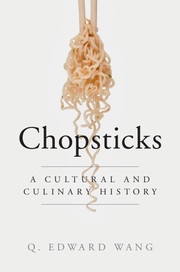Book contents
- Frontmatter
- Dedication
- Contents
- Acknowledgments
- List of Plates
- Timeline
- Map of East Asia
- 1 Introduction
- 2 Why chopsticks? Their origin and original function
- 3 Dish, rice or noodle? The changing use of chopsticks
- 4 Forming a chopsticks cultural sphere: Vietnam, Japan, Korea and beyond
- 5 Using chopsticks: customs, manners and etiquette
- 6 A pair inseparable: chopsticks as gift, metaphor and symbol
- 7 “Bridging” food cultures in the world
- Conclusion
- Glossary
- Bibliography
- Index
- Plate section
- References
Conclusion
Published online by Cambridge University Press: 05 February 2015
- Frontmatter
- Dedication
- Contents
- Acknowledgments
- List of Plates
- Timeline
- Map of East Asia
- 1 Introduction
- 2 Why chopsticks? Their origin and original function
- 3 Dish, rice or noodle? The changing use of chopsticks
- 4 Forming a chopsticks cultural sphere: Vietnam, Japan, Korea and beyond
- 5 Using chopsticks: customs, manners and etiquette
- 6 A pair inseparable: chopsticks as gift, metaphor and symbol
- 7 “Bridging” food cultures in the world
- Conclusion
- Glossary
- Bibliography
- Index
- Plate section
- References
Summary
To end this book, I would like to share a personal story. When I was four or five, my mother, who has been a busy career woman all her life, sat me down one afternoon, asking me to practice the correct use of chopsticks. Of course, as a child growing up in China, I had been using chopsticks, along with a spoon, to eat before then. But my mother thought that I had reached the right age to learn to use chopsticks the right way. She taught me the correct method and asked me to clasp and move my toy wooden blocks spread on the table. What a long and grueling afternoon! I did not, initially, feel natural holding and using the chopsticks in the way she taught me. But in the end, I got used to it. And I have been using the utensil this way ever since.
I assume my experience was not uncommon among my generation, for as I was growing up, I saw many people use chopsticks the same way. Of course, I also saw some others who used the utensil in their own self-developed ways. Honestly, I must say that I find my way, or the way I learned from my mother, both more elegant and effective. In more recent decades, as an academic, I have traveled extensively across Asia. I have seen that most Japanese, Vietnamese and Koreans hold chopsticks in the same way that I do. How is this so? Did they have similar childhood experiences? Why do so many people in the region, or in the chopsticks cultural sphere, bother to learn to use the implement to convey foods?
- Type
- Chapter
- Information
- ChopsticksA Cultural and Culinary History, pp. 166 - 170Publisher: Cambridge University PressPrint publication year: 2015

